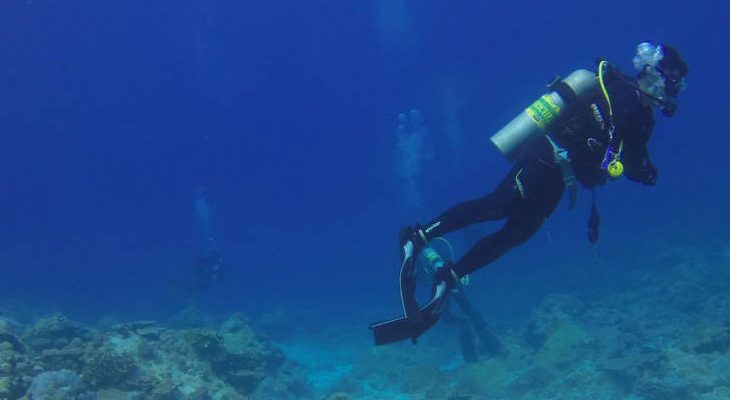Having spent the last year training to Scuba dive with BSAC in the chilly waters of the UK coast (and the odd quarry or two), I am looking forward to dipping my fins into warmer waters, and exploring Southern Africa from a new angle, during my next visit. I’ve been researching some of the best places to go and thought a list might be useful to others.
Out of the World’s Top 100 dive sites, 20% are in Africa, so there’s no shortage of stunning spots to explore. These five are the pick of the bunch, and I hope to experience them myself in the next few months – come back for an update of how I get on!
Five great dives in Southern Africa
1.Bazaruto, Mozambique
A marine protected area with dugongs, dolphins, whales and turtles. The local communities share in the tourism revenues from the marine park. The park covers an area of 1430 km2, and consists of the five islands in the archipelago and the surrounding water
2. Avalanche Reef – Port Elizabeth, South Africa
A popular dive site just off Port Elizabeth featuring overhangs and profound crevices. This rough reef has a length of 150 to 200 meters and reaches depths between 17 and 28 meters. The site is home to numerous reef fish such as Bronze Breams and Red Romans. The water here is colder and a dry suit may be preferable.

3. Nkhata Bay, Lake Malawi
Apparently there are nearly 1000 species of freshwater fish, and with warm waters and great viability diving in Lake Malawi feels almost aquarium-like! Plus the lake is a massive – 560km long and 80 km wide, so there are plenty of places to explore, and multiple different centres operating along it’s edges.
4. Aiwol Shoal, South Africa
Located 50km south of Durban, this is the famed spot to see Ragged-tooth sharks (supposedly much more docile than they look!). The best time to see them is between June- November when they congregate on the shoal to mate. Tiger Sharks and Hammerheads are also regularly seen.
The area has been classified as a marine protected area so you’ll need a permit to dive there (which can be obtained with some dive agencies or local post office).
5. Hunga Reef, Zanzibar
One of the best dive sites in Zanzibar, this stunning reef is at 16-18m, four nautical miles out at sea. See shoals of snappers and barracudas, alongside unicornfish, parrotfish and many different species of nudibranch and flatworm.
Tips for finding a reputable dive center
It can sometimes be difficult to establish how good a dive site is from their website, or perhaps even at a quick glance when you arrive, so here are some general tips and questions to ask (yourself and the centre) to ensure you have a safe and enjoyable dive!
- Check for a dive agency affiliation. When abroad this will most commonly be PADI, but BSAC and SSI are good ones too.
- Does the centre have a good safety record and are the instructors well qualified – have a look at their instructor card.
- Look at the standard of the equipment on offer, does it look well maintained and has it been tested recently? Check the marking on the tanks and ask to see the latest test certificates.
- Is the boat properly kitted out for divers? Does it have oxygen on board? Take a look at boat logs from previous dive trips.
- If you have no qualifications you should always dive with a qualified instructor (with a maximum of 2-3 trainees per instructor)
- There should never be more than 8 (already certified) divers underwater to a single Dive Master. This is the legal limit.
If you are not fully satisfied about any aspect, do not go diving. Simple.
Finally, never dive below your qualified depth or ascend quickly, and always leave at least 24 hours after your last dive before flying (and have fun too!).

What to take with you
- Qualification card
- Appropriate insurance
- Dive computer
- Mask
- Dive log book
Most dive centres can hire the rest for around $20 or some even include hire in the dive cost.
Things to avoid on a Southern African diving trip
Cage Diving. A controversial topic, especially in South Africa. Personally this is not an activity that I agree with. Sharks are naturally shy creatures, and wouldn’t typically approach humans – despite the myths – but they are quick learn to associate boats (and therefore people) with food. The artificial feeding of sharks, has led to competition between species and a change in their natural behaviour. For more information, I’ve recently came across this excellent opinion piece written by Digital Nomad on National Geographic, which sums up the issues very coherently. The comments section highlights the complexity of the debate. If you are still keen on cage diving, a few things to look out for in an operator are listed at the end of the article.
Damaging Marine Environment
Be as careful around reefs as possible. Have good buoyancy and control of fins. Don’t touch or let your let body come into contact with marine life, and don’t let equipment hang loose and drag.
Purchasing Shells and Coral
Avoid purchasing sea life souvenirs, such as shells, corals or dried seahorses. They may look pretty but in many cases they have been collected alive and dried.
Quick and cheap scuba classes. This is not to say that just because it is expensive it’s good, but you certainly do not want to rush any of the training elements. Don’t squeeze important skills into a very short time frame. You are more likely to comfortable and competent in the water if you have not rushed your learning.







 Jessica has an interest for sustainable tourism, and is particularly passionate about Southern Africa and all it has to offer. She is currently overlanding across 10 countries in the bottom half of the continent, and creating these resources en-route, to help others plan their own African adventures.
Jessica has an interest for sustainable tourism, and is particularly passionate about Southern Africa and all it has to offer. She is currently overlanding across 10 countries in the bottom half of the continent, and creating these resources en-route, to help others plan their own African adventures.